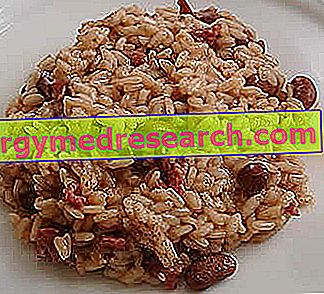Introduction
Many supporters of so-called "modern diets", which tend to be low in carbohydrates, believe that legumes are harmful to health. Not only that, in the list of "to avoid" foods, cereals, pseudocereals, some tubers or roots (potatoes, American potatoes, tapioca, etc.) and their derivatives (flours, isolated starch, etc.) are often included.

legumes
What are Legumes?
By legumes (also called leguminous or papilionaceae) we can mean:
- The herbaceous or arboreal plants of the Fabaceae Family
- The fruits of the same plants, which are generally made up of pods containing some seeds.
The edible portion of legumes consists of the pod and / or what it contains; intended as food, legumes may therefore be of the "seed" or "immature pod" type.
Most of the "consumer" ones are foods characterized by the chemical prevalence of starch, followed by a good dose of protein and an excellent amount of fiber. Lipids are instead usually marginal, with some well-known exceptions (which we will see below).
Legumes of large consumption
Let us now turn to the description of the most common legumes in the world diet. Below we will do, for convenience, a short list of the most consumed, dividing them by food type:
- Starchy seeds of legumes : borlotti beans, cannellini beans (or white beans), spagna beans, peas, chickpeas, lentils, broad beans, lupins, chickpeas, black-eyed beans, azuki beans (or aduki or adzuki), black beans (or mung) or Indian) etc. Note : carob is a legume of marginal consumption.
- Fatty legume seeds : peanuts, soy
- Immature pods, whole edible: green beans (or tegolini), taccole (or pea mangiatutto).
Nutritional Properties
Nutritional characteristics of legumes
Legumes, especially starchy ones (which represent most of the legumes produced and consumed), are foods that belong to the IV fundamental group of foods. The immature pods seem more pertinent to the VI and VII together (vegetables); the fat ones do not have a very distinct location and have intermediate properties between starchy and oily seeds.
In raw, fresh or frozen form, legumes provide a rather significant amount of energy, but not too high. Most calories, as we have already said, are provided by complex carbohydrates; in particular from starch. Follows a far from negligible percentage of proteins with a medium biological value, in which the sulfur amino acids methionine and cysteine are lacking. The fats are quantitatively marginal, even if of excellent quality (mainly unsaturated and with an excellent percentage of essential polyunsaturated fats) and accompanied by very useful elements such as phytosterols and lecithins. The fibers are abundant and diminish only in the dehulled seeds (deprived of the external integument).
Legumes contain B vitamins in abundance, such as B1 (thiamine), PP (niacin), folic acid, etc .; they are also an excellent source of minerals such as calcium, iron, phosphorus, potassium, etc.
Legumes do not contain gluten, lactose or histamine (and do not facilitate their release by the body), but there are several allergic and widespread forms, such as soy and peanut
. Leguminous plants can be very dangerous for those affected by favism. They are very consumed foods in vegetarian nutritional regimes, even religious or philosophical as Buddhism and Hinduism.
Do they make you fat?
Do excess legumes make you fat?
To the question: "Do legumes make you fat?", We could answer without delay: "Obviously not, legumes are not fattening, or at least no more than any other food".
Leguminous plants contain about 70-110 kcal / 100 g, with the due differences relating to the specific case. Cooked and preserved in a can in the liquid they tend to absorb a small concentration of water, therefore the nutritional density tends to decrease slightly. On the contrary, in dry form (or even ground in the form of flour) they become very caloric, reaching and exceeding 300 kcal / 100 g, although this aspect is still marginal; in fact, before cooking, all dried legumes (except for very small ones such as lentils) must be subjected to preliminary soaking which allows them to regain a considerable percentage of hydration. In cooking, the absorbed water increases further.
In fact, even for legumes there are precise consumption recommendations, which affect the frequency as much as the portion. Legumes can be used as a first course in the form of soup or boiled, as an ingredient for mixed first courses (for example pasta and beans, rice and peas, etc.) or as a side dish. To be consumed 2-3 times a week, they have an average portion corresponding to:
- 150 g for fresh, frozen or cooked legumes (half a plate, a small, drained can)
- 50 g for dry ones or flours (2-3 tablespoons)
- 100 g for fermented soy products (tofu, tempeh, etc.).
Excess
Do excess legumes make you fat?
Like all foods, if taken in excessive quantities, legumes can contribute to overweight. This is especially true when taken in the form of flour, in mixed dough for bread or pasta, or as other derivatives such as tofu. The legumes in broth are more rarely taken in excess, structuring hypocaloric and very satiating recipes.
On the other hand, it is a good idea not to overdo it; below we will find out better why.
Do excess legumes hurt?
It must be remembered that legumes contain a good deal of anti-nutritional molecules.
Constituted by chelating agents, such as oxalic acid and phytic acid, but also by enzyme protease inhibitors, the antinutritional factors of legumes can be totally eliminated after:
- Soaking the dried seeds: during the chemical-physical exchange between the dry seeds and the liquid, the water enters the skin and some molecules come out, for example oxalates and phytates. Alternatively you can choose dehulled seeds.
- Cooking: they are thermolabile molecules and lose their effect when subjected to intense and / or prolonged heat.
Note : some nutritional factors, at normal concentrations, have a positive function in the body, such as fibers, tannins and certain polyphenolci antioxidants. However, in excess, these too can reduce nutritional absorption.
The consequences of an excess in anti-nutritional molecules are the lack of generalized absorption (as in the case of fibers) or specific absorption (reduction of calcium due to oxalates, decreased digestion and protein absorption, etc.). Some of these effects are clearly noticeable due to the onset of bloating, abdominal tension, bloating, flatulence and sometimes diarrhea.



